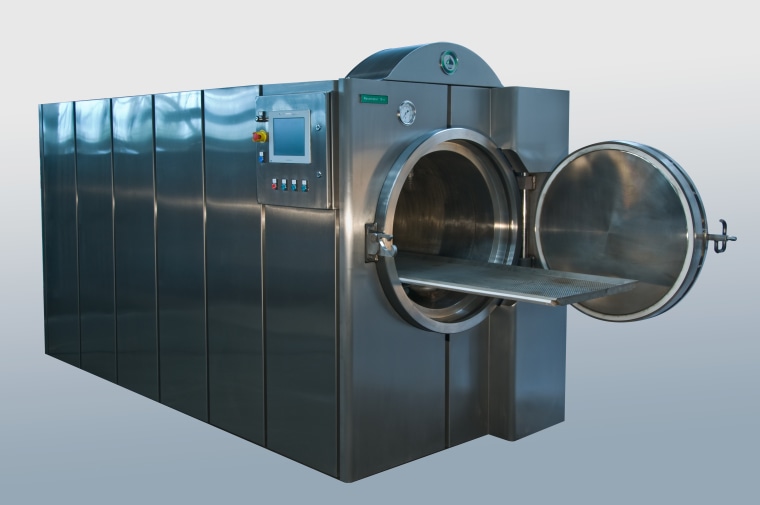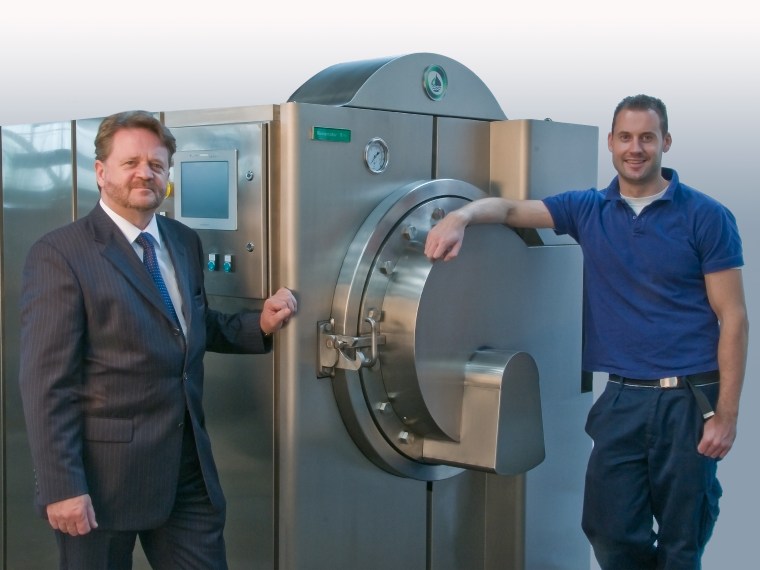From dust we are, and to dust we shall return — by burial, cremation or emulsification.
As some Americans push ever harder to leave a smaller carbon footprint on the environment, the funeral industry is taking a new step to help us go even more gently into that good night. Instead of a traditional burial, which takes up space six feet underground, or cremation, which uses a surprising amount of energy, the dead can now be dissolved.
“The public will at last have a true third choice to exit this planet,” said Sandy Sullivan, the Scottish biochemist credited with adapting the so-called resomation technique to human remains.
That's good news for die-hard environmentalists like Jan Nickerson of Brevard, N.C.
After learning that a Florida funeral home soon will become the first in the nation to offer resomation, Nickerson made an announcement to her family.
“When I die, if there’s a local provider that does this, great, let’s do a local provider,” Nickerson said. “But if not, we know there’s this one in St. Petersburg. Get me down there.”
Not that Nickerson, 61, is in poor health. Nothing, she says, is “imminent.” But as a lifelong lover of all things green, she would prefer to have her family transport her body 650 miles if necessary to a special tank at the Anderson-McQueen Family Tribute Centers, where her remains would be dissolved through biochemistry, not charred by fire.
Resomation, derived from a Greek word meaning "rebirth of the body," is essentially a variation of cremation, done at far lower heat with the use of high pressure and chemicals that emulsify the body.
The new body-disposal technique has been approved for use on human remains in Florida, Maine and Oregon, according to the Cremation Association of North America. Approval is being considered in several other states.
“It’s been on my bucket list to find a better way,” said Nickerson, an executive search specialist. “I’ve always felt, what a shame to use six feet of land forever for a body. And cremation takes so much heat, it’s not as earth-friendly as I’d like. I’m not an environmental evangelist who judges others. This is just my choice.”
At Anderson-McQueen, three other families with prepaid cremation contracts already have requested resomation instead of flames, said president John McQueen. He expects to launch the alternative process this spring after a one-story building is completed to house the special tank.
“We’ve always wanted to be first in the industry in many aspects,” said McQueen. For example, his business allows families to witness traditional cremations if they wish. “Many cremation consumers have higher concerns for the environment. They like the whole back-to-nature concept. So we felt this would work really well.”
Cremation itself has become an increasingly popular way to go for Americans. In 2009 nearly 39 percent of bodies were cremated nationwide, up from 25 percent a decade earlier, according to the National Funeral Directors Association.
Sullivan, the biochemist, came up with the idea for resomation while working on a European-Union funded project to apply alkaline hydrolysis, breaking down tissue with chemicals and water, to dispose of cattle with “mad cow” disease. In 2008 he launched Resomation Ltd. Sales have been slow so far, partly due to regulatory issues.
He has sold four units, priced at about $400,000 each, to funeral companies in North America — one in Canada, one to McQueen in Florida and two more to outfits in Minnesota and California, where state approval of the process is either pending or under discussion.
He expects to fill the company's first European order in the spring, once legal wrinkles are worked out.
“With our increasing environmental understanding … and the rapidly depleting supply of fossil fuels, it is clear cremation now needs to pass the baton onto a lower-energy-using technology that, like cremation, does not take up valuable land,” Sullivan said.
Here’s the morbid math: Cremating one corpse requires two to three hours and more than 1,800 degrees of heat — enough energy to release 573 pounds of carbon dioxide into the atmosphere, environmental analysts have calculated. In many cases, dental compounds, such as fillings, also go up in smoke, spewing harmful mercury vapors into the air unless the crematorium has a chimney filter.
In resomation, a body is placed in a steel chamber along with a mixture of water and potassium hydroxide. Air pressure inside the vessel is increased to about 145 pounds per square inch, and the temperature is raised to about 356 degrees Fahrenheit. After two to three hours, the corpse is reduced to bones that are then crushed into a fine, white powder. That dust can be scattered by families or placed in an urn. Dental fillings are separated out for safe disposal.
Because the tissue is not torched, resomation “typically uses one-seventh of the energy required for cremation,” Sullivan said.
Leftover liquids – including acids and soaps from body fat – plus the added water and chemicals are disposed of “through a wastewater treatment” process, said John Ross, executive director of the Cremation Association of North America, which supports the use of resomation.
“It’s very similar to the treatment of excess water from any (industrial) facility. In fact, it probably has less of a chemical signature than would you find (in liquids) coming out of most (industrial) plants,” Ross said. “Interestingly, I’ve read that testing has found no DNA remaining in that water.”
The cost to consumers who opt for water over fire in their end-of-life wishes? For now, McQueen plans to charge customers the same for resomation as he does for a traditional cremation, which typically runs $1,000 to $2,000 for a no-frills disposal.
“We don’t want price to be the objection. We’d rather see, for sure, if the consumer likes and wants it," McQueen said.
Ross, of the Cremation Association, said that some funeral homes could charge more for the perceived benefit and to help recoup their investment.
"People will pay somewhat more for something that is more environmentally preferable to them,” Ross said. “But there is a limit to how much people will pay.”

Cremation typically saves at least several hundred dollars over a traditional burial and possibly far more when the cost of things like a cemetery plot and grave marker is figured in.
To make resomation legal in McQueen’s state, the Florida Cemetery, Cremation and Funeral Association last year had to ask state officials to amend state laws, and then had to obtain a local disposal permit.
“You have to go before the water-quality people (in St. Petersburg), and then they have to have samples and test numbers – all the things they do to make sure it’s safe for the sewer system,” McQueen said. “We got the permit in December.”
Similar legislative discussions are set to begin in Colorado where the state funeral association will push a bill this year. The new law seeks to ensure that resomations are covered by the same regulatory requirements now applied to traditional cremations.
For cremations in Colorado, “air emissions are regulated. Now, we want to make sure ground waste is covered as well,” said Steffani Blackstone, executive director of the Colorado Funeral Directors Association.
One of the chief issues for Blackstone is that consumers understand all the steps of resomation, how it works — and its final byproducts.
“What they picture is the end result,” Blackstone said. “When we try to explain the (resomation) process to people, what we’ve noticed is they’re kind of grossed out.
“Our only concern is that crematories that use this process need to disclose to the families that they are using a different method, because we don’t want (consumers) to be surprised,” she said.
“People seem to have objections when they actually think about that too long. They ask: ‘Well what happens? Does (the body) turn to sludge?’ And the thought of grandma being sludge is kind of disgusting to them.”
Bill Briggs is a frequent contributor to msnbc.com and author of the new book, “The Third Miracle.”
